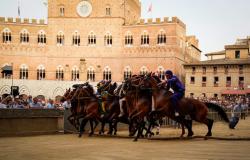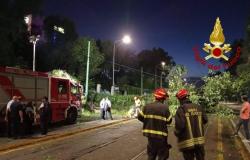Interview in L’Osservatore Romano with Father Ramina, rector of the basilica, a destination for millions of pilgrims: “A universal population is devoted to the Saint. He wins over so many people because he knows how to welcome and listen to everyone, no one excluded”
Alvise Sperandio – Vatican City
Millions of people go to the tomb of Saint Anthony of Padua every year, lining up to pray and touching the tombstone with their hands. And on June 13, in the liturgical memory dedicated to him (the anniversary of his death), the pilgrimage is renewed incessantly with thousands of visits from dawn to dusk on one of the brightest days of the year. Anthony (Lisbon, 1195 – Padua, 1231), Franciscan priest and doctor of the Church canonized in 1232, is one of the most beloved saints in the world, “the Saint” par excellence, just as Padua in the collective imagination is identified as “the city of the Saint”. In the pontifical basilica governed for three years by Father Antonio Ramina, 54 years old, from Vicenza, of the Franciscan Order of Conventual Friars Minor, everything is ready for the celebration, preceded by the celebration of the “Tredicina” (on the thirteen previous Tuesdays). Tomorrow the program will be intense: in the morning the masses with the pontifical delegate Archbishop Diego Giovanni Ravelli and the bishop of Padua, Claudio Cipolla, in the afternoon the one with the provincial minister of the Friars Minor Conventual, Father Roberto Brandinelli, followed by the solemn procession through the streets of the city packed with faithful following the wooden statue and the relics of the saint.
Father Ramina, who is Antonio to you?
Not an immediate discovery. I entered the convent inspired more than anything by the figure of Saint Francis. I have known Saint Anthony, who as we know, met the Poor Man of Assisi, as an original interpreter of Franciscanism. He fascinated me for two reasons: his love for the word of God, with great space for silence, meditation, prayer, and the extraordinary strength of his preaching, always in favor of the poor.
Why is this saint so venerated?
It’s a bit of a mystery: there are many “nice” saints close to people. I think that Saint Anthony wins over so many people because he knows how to welcome and listen to everyone, without exception. And because he transmits the affective dimension of faith to everyone.
Who are the devotees of Saint Anthony of Padua?
It is a universal people: there are men and women, young and old, rich and poor, sick and healthy, people with high qualifications or less. Not necessarily believers, on the contrary. We friars who look after the basilica see how everyone really approaches his tomb because his call has no barriers or differences.
What are people looking for in San Antonio?
Above all consolation and support. Saint Anthony is a traveling companion, a friend on the personal journey of each of us. Many go to ask for intercession for health problems, asking for healings, miracles, graces. In this sense the many photos ex voto displayed near the tomb they are a powerful testimony and show the universal face of the Church. Furthermore, the gratitude for the gifts received is very strong.
What is in the gesture of touching the tombstone?
It is not magic or superstition but it reminds us that our life of faith cannot just be thought, feeling, good intention, but is also entering into a life lived, a concrete story. This continuous pilgrimage helps us to re-motivate ourselves on the journey of faith.
Every question of health always implies a question of salvation.
When a person approaches the grave due to illness, he rightly asks for healing. But the real miracle, as also happens in Lourdes, is that other spaces open up in prayer. The evangelical “ask and it will be given to you” is fine but it shouldn’t be forgotten that it doesn’t necessarily arrive. What matters is trusting God who is there, at our side, with our wounds and our struggles and never leaves us.
What is the relevance of the saint in today’s opulent and super-technological society?
He meditated a lot and spoke forcefully. Anthony is the saint of interiority. He has never been worried about exhibiting or showing who knows what. Being and appearing in him are together. “I am what I appear to be,” he loved to say. Let’s all learn it.
What is the point of contact with Saint Francis of Assisi?
Both were not interested in exegesis or culture per se but that the voice of the Lord, the call to vocation, was recognized in the word of God. There is a profoundly correct saying: “let words cease and deeds speak”.
The procession through Padua is a sign of faith and testimony in an increasingly de-Christianized “civis”.
It is to the extent that it knows how to generate connections. Those who walk behind the statue are an ecclesial community that finds itself and recognizes itself in faith in God through the intercession of Saint Anthony, and always to the extent that it relies on mediation, even if it is not fully understood.
In this time of war, how can Saint Anthony help peace?
In the poster for the Antonian June we see the saint standing before the tyrant asking him to renounce violence: he doesn’t succeed but his courage to express strong reasons for peace is prodigious. It’s a bit like the Pope who incessantly, at every opportunity, calls for peace, but seems not to be listened to. Antonio teaches us to never let go and to promote a peace that must first of all arise from our hearts and our daily lives. We are all called to conversion. Peace in the world depends on the powerful of the earth but also on our personal commitment.
Your greeting “Peace and good” is a hymn to life.
Peace is the hope that no one will ever feel so far from God that they cannot start again, even getting back up after the falls caused, above all, by our sins. While good means seeking beautiful relationships, perhaps simple and yet authentic, the only ones that are valuable in life.





